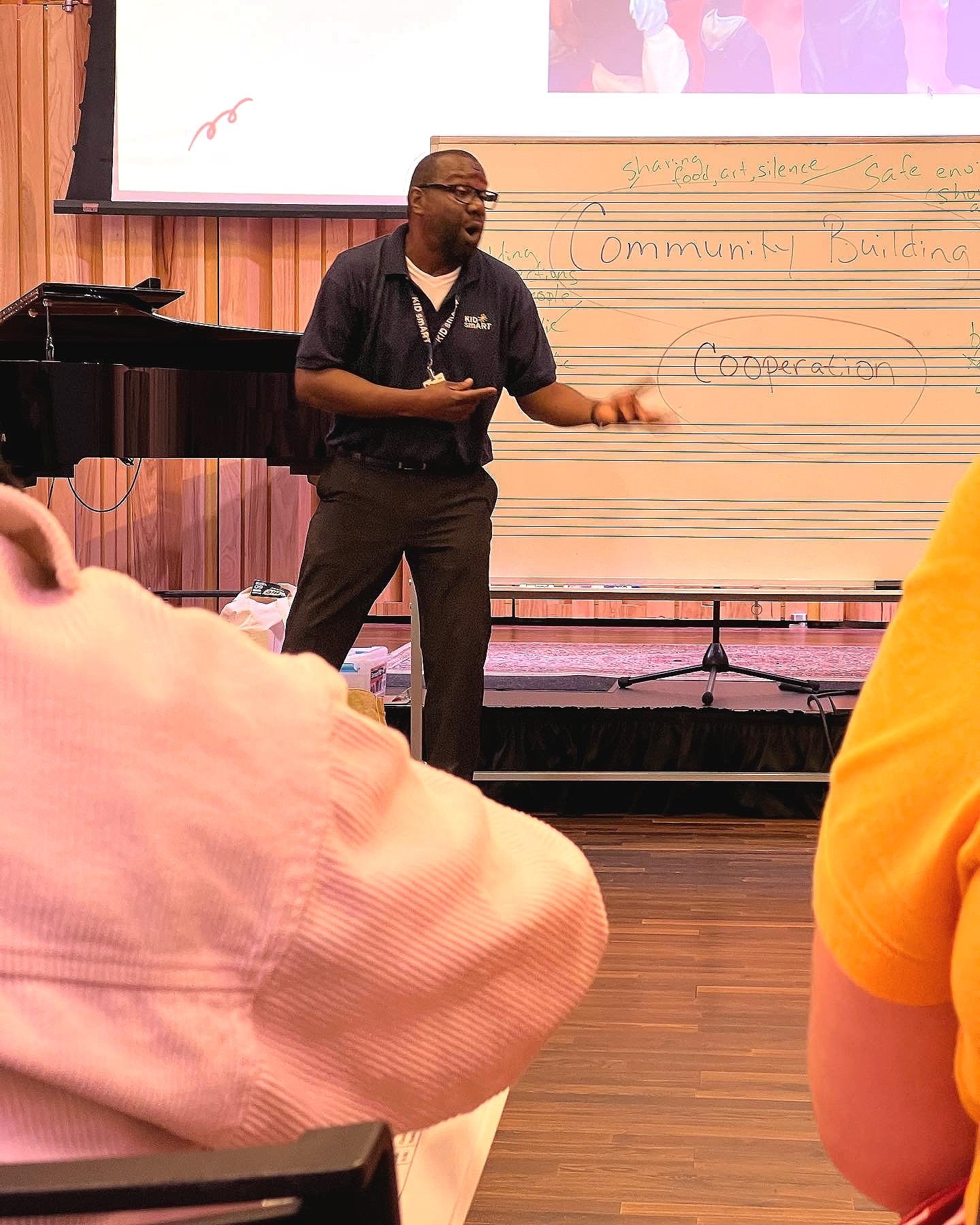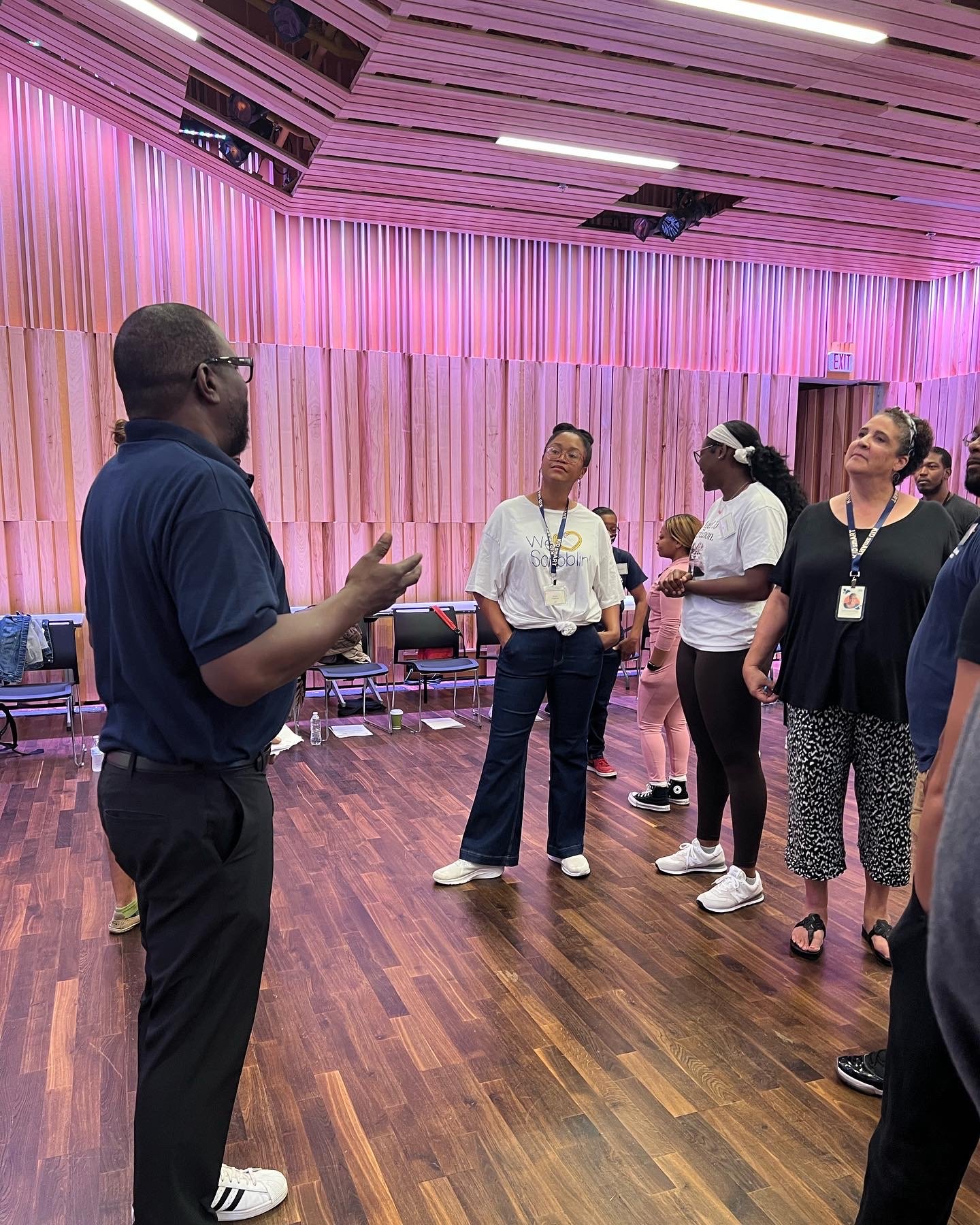How to use the arts to build community in your classroom
Building Community within a learning environment is an invaluable experience that will engage, surprise, and inspire participants. Utilizing drama/theatre strategies (pantomime and improvisation) to facilitate Building Community is an excellent catalyst for demonstrating collaboration, effective communication, and joyful learning. The basic structure consists of a warm-up (physical/vocal), a main activity (learning objective), and a closing (debrief/reflection). Below is a sample lesson plan.
Objective 1: Participants will be able to utilize pantomime to share one of their favorite activities.
Welcome participants; share the structure of the lesson; articulate the objective.
Warmup: Physical/Vocal
Ask participants to stand in a circle
Lead participants in a physical warm-up (stretch up, lean forward, neck rotations, shoulder rotations forward and backward, shake out arms, legs, then whole body)
Ask participants to repeat tongue twisters deliberately over-articulating and over-enunciating (Unique New York, New York Unique, Red Leather Yellow Leather, Yellow Leather Red Leather, etc.)
Tell participants you’re going to put on the music. When the music starts, participants will walk, dance and move throughout the space. When the music stops, they will find a partner and be given a prompt to answer. When the music starts again, they will walk, dance and move throughout the space, and when the music stops, find a different partner.
Repeat the above process three times utilizing general to specific prompts; i.e., prompt #1, discuss with your partner an activity you enjoy; prompt #2, discuss one positive quality you bring to a group or team
Ask participants to return to their seats
Debrief: What happened? How did it feel? What stood out for you?
Building Knowledge
This part of the lesson allows participants to ‘brainstorm and define terms.’
Write the words ‘Building Community’ on the board or chart paper and then circle.
Ask participants, ‘What comes to mind when you see or hear the words ‘Building Community’?
Record responses, creating a ‘web.’
Synchronize responses, e.g., building a community means to construct a respectful, inclusive, and accountable environment; sharing, caring; being helpful and kind; working together towards a shared goal.
Repeat using the word ‘pantomime’
Guided Practice
This part of the lesson includes modeling activities and demonstrating strategies
Ask participants to stand in a circle
Tell participants they are going to say their names and enact one activity they enjoy doing utilizing ‘pantomime.’
Modeling: Utilizing the prompt, ‘My name is _______ (say name) and I like to (step forward and enact activity without using words or sound, then step back and name activity) ______(cooking).
Independent Practice
This part of the lesson allows participants to utilize prompts from guided practice to complete the activity. Each participant shares their activity using ‘pantomime.’
Debrief/Reflection
What happened? How did it feel? What stood out for you? How did the activity help to build community?
Objective 2: Participants will be able to utilize improvisation to demonstrate collaboration.
Building Knowledge:
Review components of ‘building community’ web definition.
Ask participants what ‘collaboration’ means. Record responses.
Synchronize ideas, ‘collaboration means to work together to create something; to cooperate with one another
Write ‘improvisation’ on the board or chart paper; define improvisation as spontaneous creation, to freestyle; to make it up on the spot
Ask participants to stand in a circle.
Tell participants they are going to use their voice and body to create a simple movement and sound that can be repeated four to five times
Modeling/Guided Practice
Demonstrate several sounds and movements. Ask participants to repeat your sound and movement.
Each participant will share their sound and movement; the group repeats the sound and movement.
Independent Practice
In small groups, participants will collaborate to create an original machine with sound and movement.
Divide participants into small groups and ask each group to find a space in the room
Ask participants to number themselves 1 through however members are in the group.
Ask #1 to share their sound and movement then #2, then #3, etc. repeat time permitting
Call each group back to the whole group
Tell participants they are going to share their sound and movement with the whole group, ‘collaborating’ to create a spontaneous machine.
Ask for group volunteers and have them stand in a small circle
Tell participants the audience will say ‘1,2,3, action’ and group member #1 will share their sound and movement (keep repeating)
Then I’ll say #2; group member #2 joins with their sound and movement (keep repeating); until all group members are enacting and repeating their sound and movement together.
Tell volunteers when they hear their number called again to stop
Ask and answer any clarifying questions
Ask the audience to say 1,2,3 action
Group member #1 starts their sound and movement (repeating)
Say #2; group member #2 joins #1 with their sound and movement
Say #3; group member #3 adds their sound and movement
Repeat until all group members are sharing their sounds and movement simultaneously
Allow two to three reps with all group members collaborating.
Say #1; number 1 stops; say #2; number two stops; continue until all group members have stopped. FREEZE.
Ask the audience to applaud for the group
Ask for another group of volunteers; repeat the process with the remaining groups time permitting
Debrief/Reflection
What happened? How did it feel? How did you demonstrate or show collaboration? What does collaboration have to do with building community?
Whip Around: Using a word, phrase, or sentence, how would you describe your experience ‘Building Community’?


